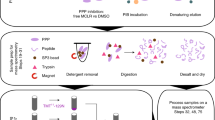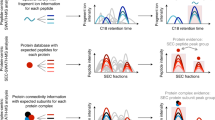Abstract
We report a proteomics strategy to both identify and quantify cellular target protein interactions with externally introduced ligands. We determined dissociation constants for target proteins interacting with the ligand of interest by combining quantitative mass spectrometry with a defined set of affinity purification experiments. We demonstrate the general utility of this methodology in interaction studies involving small-molecule kinase inhibitors, a tyrosine-phosphorylated peptide and an antibody as affinity ligands.
This is a preview of subscription content, access via your institution
Access options
Subscribe to this journal
Receive 12 print issues and online access
$259.00 per year
only $21.58 per issue
Buy this article
- Purchase on Springer Link
- Instant access to full article PDF
Prices may be subject to local taxes which are calculated during checkout



Similar content being viewed by others
References
Kruse, U., Bantscheff, M., Drewes, G. & Hopf, C. Mol. Cell. Proteomics 7, 1887–1901 (2008).
Knight, Z.A. & Shokat, K.M. Chem. Biol. 12, 621–637 (2005).
Zhang, J., Yang, P.L. & Gray, N.S. Nat. Rev. Cancer 9, 28–39 (2009).
Daub, H. Biochim. Biophys. Acta 1754, 183–190 (2005).
Brehmer, D. et al. Cancer Res. 65, 379–382 (2005).
Bantscheff, M. et al. Nat. Biotechnol. 25, 1035–1044 (2007).
Ong, S.E. et al. Mol. Cell. Proteomics 1, 376–386 (2002).
Olsen, J.V. et al. Cell 127, 635–648 (2006).
Ono, M. & Kuwano, M. Clin. Cancer Res. 12, 7242–7251 (2006).
Zhang, Y.X. et al. Cancer Res. 68, 1905–1915 (2008).
Ong, S.E. et al. Proc. Natl. Acad. Sci. USA 106, 4617–4622 (2009).
Cox, J. & Mann, M. Nat. Biotechnol. 26, 1367–1372 (2008).
Cheng, Y. & Prusoff, W.H. Biochem. Pharmacol. 22, 3099–3108 (1973).
Hinsby, A.M., Olsen, J.V. & Mann, M. J. Biol. Chem. 279, 46438–46447 (2004).
Daub, H. et al. Mol. Cell 31, 438–448 (2008).
Wissing, J. et al. Mol. Cell. Proteomics 6, 537–547 (2007).
Schulze, W.X., Deng, L. & Mann, M. Mol. Syst. Biol. 1, 2005.0008 (2005).
Blencke, S., Ullrich, A. & Daub, H. J. Biol. Chem. 278, 15435–15440 (2003).
Shevchenko, A., Tomas, H., Havlis, J., Olsen, J.V. & Mann, M. Nat. Protoc. 1, 2856–2860 (2006).
Rappsilber, J., Mann, M. & Ishihama, Y. Nat. Protoc. 2, 1896–1906 (2007).
Schroeder, M.J., Shabanowitz, J., Schwartz, J.C., Hunt, D.F. & Coon, J.J. Anal. Chem. 76, 3590–3598 (2004).
Olsen, J.V. et al. Mol. Cell. Proteomics 4, 2010–2021 (2005).
Maere, S., Heymans, K. & Kuiper, M. Bioinformatics 21, 3448–3449 (2005).
Shannon, P. et al. Genome Res. 13, 2498–2504 (2003).
Adachi, J., Kumar, C., Zhang, Y., Olsen, J.V. & Mann, M. Genome Biol. 7, R80 (2006).
Godl, K. et al. Proc. Natl. Acad. Sci. USA 100, 15434–15439 (2003).
Hibi, M., Lin, A., Smeal, T., Minden, A. & Karin, M. Genes Dev. 7, 2135–2148 (1993).
Acknowledgements
We thank A. Ullrich for his support of the present study with his doctorate student M.B. and funding from the Department of Molecular Biology, Max Planck Institute of Biochemistry, Martinsried and M. Mann for support. K.S. was supported by research fellowships from the Max Planck Society and the Alexander von Humboldt Foundation. This work was supported by a grant from the Deutsche Krebshilfe.
Author information
Authors and Affiliations
Contributions
K.S., C.W. and M.B. contributed to the experimental design, performed experiments and analyzed data. Z.G. and G.K. prepared small-molecule inhibitors. J.C. provided tools for data analysis and contributed to data analysis. J.V.O. provided mass spectrometry expertise and contributed to the experimental design and data analysis. H.D. designed the study, performed data analysis and wrote the paper.
Corresponding author
Ethics declarations
Competing interests
A patent application of the proteomics approach described in this study has been filed and has been licensed to Kinaxo Biotechnologies GmbH, Martinsried, Germany. H.D. is a shareholder of Kinaxo Biotechnologies GmbH, and H.D., J.V.O. and J.C. have consultancy agreements with Kinaxo Biotechnologies GmbH. Z.G. and G.K. are shareholders and employees of Vichem Chemie Ltd. Budapest, Hungary.
Supplementary information
Supplementary Text and Figures
Supplementary Figures 1–7, Supplementary Tables 1–7, Supplementary Note and Supplementary Discussion (PDF 594 kb)
Supplementary Data 1
Protein groups data of AX14596 and gefitinib experiments (XLS 2676 kb)
Supplementary Data 2
Peptide evidences data of AX14596 and gefitinib experiments (XLS 25918 kb)
Supplementary Data 3
Quantification results and Kd and IC50 values for specific cellular targets of AX14596 and gefitinib (XLS 55 kb)
Supplementary Data 4
Protein groups data of VI16742 and SB203580 experiments (XLS 2346 kb)
Supplementary Data 5
Peptide evidences data of VI16742 and SB203580 experiments (XLS 22794 kb)
Supplementary Data 6
Quantification results and Kd and IC50 values for specific cellular targets of VI16742 and SB203580 (XLS 234 kb)
Supplementary Data 7
Protein groups data of IRS4-pY921 peptide interaction experiments (XLS 3379 kb)
Supplementary Data 8
Peptide evidences data of IRS4-pY921 peptide interaction experiments (XLS 16562 kb)
Supplementary Data 9
Quantification results and Kd values for specific cellular interactors of IRS4-pY921 peptide (XLS 282 kb)
Supplementary Data 10
Protein groups data of EGFR immunoprecipitation experiments (XLS 1214 kb)
Supplementary Data 11
Peptide evidences data of EGFR immunoprecipitation experiments (XLS 4082 kb)
Supplementary Data 12
Quantification results for specific cellular interactors of the EGFR (XLS 22 kb)
Rights and permissions
About this article
Cite this article
Sharma, K., Weber, C., Bairlein, M. et al. Proteomics strategy for quantitative protein interaction profiling in cell extracts. Nat Methods 6, 741–744 (2009). https://doi.org/10.1038/nmeth.1373
Received:
Accepted:
Published:
Issue Date:
DOI: https://doi.org/10.1038/nmeth.1373
This article is cited by
-
The emerging role of mass spectrometry-based proteomics in drug discovery
Nature Reviews Drug Discovery (2022)
-
Kinase inhibition profiles as a tool to identify kinases for specific phosphorylation sites
Nature Communications (2020)
-
Chemical proteomics reveals target selectivity of clinical Jak inhibitors in human primary cells
Scientific Reports (2019)
-
Epigenetic drug target deconvolution by mass spectrometry–based technologies
Nature Structural & Molecular Biology (2019)
-
Global profiling of protein–DNA and protein–nucleosome binding affinities using quantitative mass spectrometry
Nature Communications (2018)



